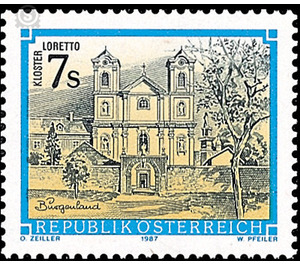monasteries - Austria / II. Republic of Austria 1987 - 7 Shilling
Theme: Architecture
| Country | Austria / II. Republic of Austria |
| Issue Date | 1987 |
| Face Value | 7.00 |
| Color | blue |
| Printing Type | combination printing |
| Stamp Type | Definitive |
| Item Type | Stamp |
| Chronological Issue Number | 1237 |
| Chronological Chapter | OOS-OE2 |
| SID | 629175 |
| In 107 Wishlists | |
Loretto, today a district of the market town Leithaprodersdorf with about 270 inhabitants, is located on the northern slope of the Leitha Mountains near the Burgenland provincial capital Eisenstadt. The name of this place was Loretto, not far from Ancona on the Italian Adriatic coast, where, since the end of the 13th century, there was a small sandstone and brick building that had become the center of Marian devotion. The history of the monastery and the town of Loretto in Burgenland began in this Italian pilgrimage site in the 17th century. The owner of the manor Hornstein, Hans Rudolf von Stotzingen, had brought from a trip to Italy a copy of the image of grace of Loretto, which was initially placed in his castle in Seibersdorf. On September 8, 1644, this statue of Mary was transferred to a newly built replica of the Holy House on the site of the destroyed by the Turks in 1529 St. John's Chapel in Loretto. This also began the influx of pilgrims to Loretto. To ensure the pastoral care of the pilgrims, the neighboring Stotzing was raised to the parish and handed over to the Order of the Servites. Soon a small monastery was built next to the Loretto Chapel. Today's Parish and Pilgrimage Church of the Immaculate Conception is a Baroque building of the 17th and 18th centuries between the cloister with the Chapel of Mercy and the monastery.


